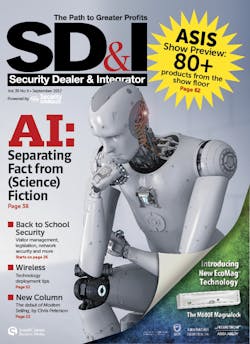For many years, it seemed that Hollywood had the market cornered on Artificial Intelligence. It grew from Isaac Asimov’s collection of stories in the 1940s to visions of robots sitting in “The Thinker” pose in the movie based on his writings.
Thus, it is no wonder that when the words Artificial Intelligence are uttered in just about any tech industry, thoughts turn immediately to Arnold Schwarzenegger as the Terminator or to Haley Joel Osment, who masterfully portrayed an intelligent robot boy in the movie aptly titled, “A.I.”
That seems to be the uphill climb for today’s video surveillance and other manufacturers, who are tasked with integrating and then marketing AI to security integrators and end-users – how to dispel the pre-conceived perceptions of what Artificial Intelligence really is.
AI itself is a buzzword, but there are similar descriptive words and phrases that all seem to be lumped into the same family by product marketers – like “deep learning” or “machine learning” or “content analytics” or even “cognitive computing” and “neural networks.” So how do security integrators and end-users make sense of the buzzwords without immediately turning their thoughts to Skynet’s impending nuclear attack?
“There is much abuse by manufacturers and solution providers in claims that they embed Artificial Intelligence technology,” says systems integrator Darnell Washington, President/CEO of SecureXperts Inc. “When I attend the many conferences across the country in IT and physical security every year (especially ASIS, ISC West and RSA), I have a great time – and a good laugh – hearing the sales and marketing folks lustily tossing around statements that their products and technologies are based on AI.”
Forget about the seemingly infinite intelligence of Lt. Commander Data of Star Trek fame – for security integrators to make smart decisions when a manufacturer throws a handful of buzzwords at the wall, it takes the intelligence that only a human can offer to sort out fact from science fiction.
“Your goal and intent should not be to turn into an expert in the subject area – but to instill a sense of awareness when you hear this type of terminology being used in the context of physical security applications,” Washington says.
True Artificial Intelligence: Nearly Impossible to Find in Security
“When you get to the bottom of what AI really is, we should think of the use cases where a machine can decide on an action to take without human intervention,” Washington explains. “One of the best examples we are familiar with is Siri and Echo – both systems use natural language to assist in research, perform tasks, and retain and learn from previous queries.”
For the record, Washington defines Artificial Intelligence as the ability of a machine to think for itself. “To prove that AI is present, we must be able to measure the intelligence being used,” he says. “For a relative scale of reference, large supercomputers can only create a brain the size of a fly. If this is the case, I wonder if today’s physical security products can stand up and meet the challenge of claiming to have embedded AI in their applications and solutions.”
That said, of all sectors of the security industry, video surveillance – largely thanks to fast-growing video analytic technologies – is leading the way in creating systems that can actually learn. By pure definition, however, the term AI is really a misnomer in security – in effect, a catch-all phrase for other technologies, including deep learning, machine learning and others.
“AI processes include learning (the acquisition of information and rules for using the information), reasoning (using the rules to reach approximate or definite conclusions) and self-correction – that’s why under the AI umbrella, simply, all similar or different terms are mixed together,” explains Dr. Albert Ryu, President and co-founder of video surveillance manufacturer IDIS, whose doctoral work was in the area of Artificial Intelligence.
Deep Learning: Also Nearly Non-Existent in Security
According to Jesse Clayton, Senior Manager of Product Management for Intelligent Machines at NVIDIA, to achieve a more accurate understanding of what’s happening in surveillance camera footage over a wide range of real-world environments, deep learning is required.
Deep learning is a relatively new computing model where machines are trained through many examples to make sense of raw, unstructured data. Dr. Ryu explains it is based on neural networks, but unlike a biological brain where any neuron can connect to any other neuron within a certain physical distance, these artificial neural networks have discrete layers, connections and directions of data propagation.
While they should not be technically considered “AI,” machine learning (more later) and deep learning combine to form what Washington calls a “knowledge-based system” – which form the foundation of AI and reasoning-based systems. “The neural networks are used with advanced algorithms that can attach recognition systems to match and capture locations, events, and build pattern-like memory and recording of events,” Washington explains.
“In our case, it is about making machines understand video and imagery with superhuman accuracy,” Clayton explains. “We will soon (be able to) take all of the video metadata and combine it with other sensor data, enabling machines to achieve even higher levels of understanding. Important relationships between activities will become clearer, which will help in abnormal activity detection and to create stronger situational awareness.”
As Clayton says, true deep learning is not a reality in the security space. Dr. Ryu agrees: “You might see a new tech introduction specifically called ‘deep learning’ at security exhibitions like ISC West or IFSEC,” Ryu says. “The level of technology is overestimated. It (usually) turns out to be simple facial recognition or flame/fire detection. However, sooner or later, thanks to deep learning in intelligent video surveillance, accuracy will be increased, the risk of false alarms minimized, and operators will be able to instantly search across databases and rank the events, concentrating on top-priority ones.”
Machine Learning and DSS: Here Today
Dr. Ryu explains that machine learning, at its most basic, is the practice of using algorithms to parse data, learn from it, and then make a determination or prediction about something in the world. “Rather than hand-coding software routines with a specific set of instructions to accomplish a particular task, the machine is ‘trained’ using large amounts of data and algorithms that give it the ability to learn how to perform a task,” he says.
The most common type of machine learning used in physical security systems today are known as decision support systems, or DSS. “One of the best examples of decision support systems in the physical security/public safety sector is the traffic analysis systems that are used by state and local departments of transportation,” Washington says. “They generate reports, graphs and tables based on traffic patterns and analyze how to optimize traffic flows and establish timing for stop lights and turn signals based on a multitude of collected metrics.”
Decision support systems that provide traffic monitoring are limited in their capability to support higher levels of intelligence because they are limited in the types of integration and interfaces that are connected to these systems.
Machine learning should not be confused with self-learning systems, which use what is known as cognitive computing, which, according to Washington, “involves self-learning systems that use data mining, pattern recognition and natural language processing to mimic the way the human brain works.”
The goal of cognitive computing is to create automated IT systems that can solve problems without human assistance.
To differentiate the terms, use an X-ray scanner dedicated to identifying explosives and weapons within a facility as an example. If the scanner device alerts an operator of the type of explosive or weapon, and offers the operator the recommendation of system shutdown or evacuation, this is a good explanation of cognitive computing. If the X-ray scanner can recognize the explosive or weapon based on previous instances and then sends an alert to the operator, it would be machine learning.
“In most cases, the operator will indeed make the same choice that the system suggests, but the exceptions are where human experience and judgment become most important – such as life safety and public safety situations,” Washington adds.
Analytics: Integral to Intelligence, but Not AI
Machine learning and self-learning systems would not be achievable without video content analytics; however, simply using analytics does not make a system artificially intelligent. “Most of the flagrant misuse of AI terminology is in the area of video analytics,” Washington says.
“When applied to video analytics systems, deep learning can help extract meaningful insights in real time, with the ability to analyze large volumes of video and generate alerts when anomalies in normal activity occur,” Clayton explains.
As integrators have been learning themselves, video analytics can provide the type of intelligence that adds significant ROI to end-users who deploy the systems. “A camera can learn what is normal for a manufacturing or assembly line and the time it takes for specific tasks to be completed, for example,” says Jennifer Hackenburg, Dahua Technology’s Senior Product Marketing Manager. “If a worker begins to fall behind, an alert about this abnormality would be communicated so a supervisor can assess the situation.”
In the case of smart cities, it can help with traffic management, where city planners can get a better understanding of parking structure activity; and for retail, store planners can use analytics to get insights into customer behaviors for merchandising and marketing, Clayton adds.
“It is well known that operators viewing CCTV monitors for even short durations of time become ineffective in analyzing and capturing events – that can be augmented by using intelligent systems that can detect irregularities and anomalies,” Washington says.
Washington explains there are two common types of analytics: Signature-based analytics use exact information matches to reach a conclusion, such as a name, date or time, pattern or condition (such as being on one side of a line or on the other side of it); heuristic-based (or fuzzy logic) analytics can use approximations or relative evaluations, such as going faster than other pedestrians going in the same direction.
When physical security solutions include analytics and engines, they evaluate data based on two types of analysis: content and context. Content analysis is generally based on actual, raw information generated by the system; context analysis is a more robust method because it evaluates how the actual data can be applied within a specific application or solution.
Challenge Your Vendors
There is no doubt that even though none of us will witness a Terminator robot any time soon on a trade show floor, AI and true deep learning are bound to make real breakthroughs in the security industry in the near future.
“One of the most exciting aspects of AI and deep learning in this industry is that it can transform surveillance video into high-accuracy data that can be used for operational efficiency and far more uses than just security,” Clayton says. “People have been talking about this for some time, but the technology was never up to the task.”
That said, it is important to be able to sort out claims and promises that may not be able to be kept. “Since AI is just on the cusp of becoming the next big trend in video surveillance, getting it right and explaining how the technology works will differentiate competing companies,” Hackenburg says.
Armed with at least surface knowledge of these terms, a systems integrator walking the floor with their end-user clients at ASIS will have the ammunition to verify manufacturer claims. “Next time you hear a salesperson tout their products’ capabilities using AI or other terminology, make sure they know what they are talking about,” Washington advises.
Paul Rothman is Editor in Chief of Security Dealer & Integrator (SD&I) magazine. Access SD&I's current issue, archives and subscribe at www.secdealer.com. Pick up a free copy of SD&I at ASIS booth #2125 or in the publication bins outside the show floor.






